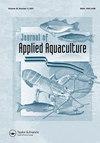低成本砾石床水培系统中植株密度和茎干修剪对植物生物量产量和经济效益的影响
IF 0.8
Q3 FISHERIES
引用次数: 0
摘要
摘要在一个低成本设计的砾石床水培系统中,研究了Oreochromis mossambicus和水果作物番茄、甜椒和黄瓜的综合产量,以最大限度地提高总产量。本研究根据生物经济学原理进行建模,分析了实验装置的系统设计和管理、生物学特性和经济性能。该研究于2018年3月至2019年2月进行。利用生长速率参数、长重关系和条件因子来确定鱼类的生长性能。利用植物密度和茎部修剪的影响来确定植物产量。番茄、甜椒和黄瓜受到两种植物密度(5和8株/m2)的影响。番茄和黄瓜植株被修剪成一个和两个茎,而甜椒植株被修剪为两个和三个茎。采用一式三份的完全随机设计。FCR为1.25;生存率97.5%;比生长率为1.64%,LWR r2为0.945,回归系数b为3.1,条件因子K为1.93。记录了总产量、适销产量、滞销产量、果实质量和数量。m2。修剪成两个茎的番茄和黄瓜植株比修剪成一个茎的植株产生了显著更高的总产量和市场产量(p<0.05)。修剪成三个茎的甜椒植株比修剪成两个茎的植株产生了显著更高的总产量和市场产量(p<0.05)。种植密度为8株/m2的番茄、甜椒和黄瓜的总产量和市场产量高于5株/m2。通过操纵环境条件、采用战略性养殖管理实践以及通过计划生产瞄准更高的市场价格,可以优化水产养殖的生物质产量,以获得更高的经济可行性。本文章由计算机程序翻译,如有差异,请以英文原文为准。
Effects of plant density and stem pruning on plant biomass yield and economic benefits in a low-cost gravel bed aquaponic system
ABSTRACT The combined yields of Oreochromis mossambicus and fruit crops – tomato, sweet pepper, and cucumber were investigated in a low-cost designed gravel bed aquaponic system to maximize overall yield. This study was modeled according to bioeconomic principles, which analyzed the experimental setup’s system design and management, biological characteristics, and economic performance. The study was conducted from March 2018 to February 2019. The growth performance of fish was determined using growth rate parameters, length–weight relationship, and condition factor. The effect of plant density and plant stem pruning was used to determine plant yield. Tomato, sweet pepper, and cucumber were subjected to two plant densities (5 and 8 plants.m2). Tomato and cucumber plants were pruned to one and two stems, while sweet pepper plants were pruned into two and three stems. A complete randomized design in triplicate was used. The FCR of 1.25; 97.5% survival rate; specific growth rate of 1.64%, LWR r2 of 0.945, regression coefficient b of 3.1 and condition factor K of 1.93 were recorded for the fish performance. Total yield, marketable yield, unmarketable yield, fruit mass, and number fruits.m2 were recorded. Tomato and cucumber plants pruned into two stems produced significantly (p < .05) higher total and marketable yields than plants pruned to one stem. Sweet pepper plants pruned into three stems produced significantly (p < .05) higher total and marketable yields than those pruned into two stems. A plant density of 8 plants.m2 produced a higher (p < .05) total and marketable yield of tomatoes, sweet peppers, and cucumbers than 5 plants.m2. Biomass yield in aquaponics can be optimized for higher economic viability by manipulating environmental conditions, adopting strategic culture management practices, and targeting higher market prices through scheduled production.
求助全文
通过发布文献求助,成功后即可免费获取论文全文。
去求助
来源期刊

Journal of Applied Aquaculture
Environmental Science-Ecology
CiteScore
3.20
自引率
0.00%
发文量
38
期刊介绍:
The Journal of Applied Aquaculture is a platform for the sharing of practical information needed by researchers to meet the needs of investors, farm managers, extension agents and policy makers working to adapt aquaculture theory to achieve economic and food security objectives in the real world. The journal emphasizes multi-disciplinary research and case studies that propose financially and logistically viable solutions to observable problems.
 求助内容:
求助内容: 应助结果提醒方式:
应助结果提醒方式:


